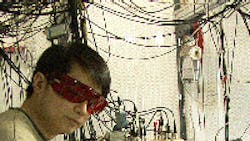Quantum logic clock is world’s best timekeeper
Move over, mercury. Physicists at the National Institute of Standards and Technology (NIST) have built an enhanced version of an experimental atomic clock based on a single aluminum atom, making it the world’s most precise clock. The new timepiece is more than twice as precise as the previous pacesetter based on a mercury atom. The new aluminum clock would neither gain nor lose a second in about 3.7 billion years, according to scientists.
This clock is the second version of NIST’s “quantum logic clock,” so named because it borrows the logical processing used for atoms storing data in experimental quantum computing, another focus of the same research group. In addition to demonstrating that aluminum is now a better timekeeper than mercury, the latest results confirm that optical clocks are widening their lead over the NIST-F1 cesium fountain clock, the U.S. civilian time standard, which keeps time to within 1 second in about 100 million years. Because the international definition of the second (in SI Units) is based on the cesium atom, cesium remains the ruler for official timekeeping, so technically no clock can be more accurate than cesium-based standards such as NIST-F1.
The logic clock is based on a single aluminum ion trapped by electric fields and vibrating at ultraviolet light frequencies, which are 100,000 times higher than microwave frequencies used in NIST-F1 and similar time standards around the world. Optical clocks divide time into smaller units, and could lead to standards more than 100 times as accurate as today’s microwave standards.
Aluminum is one contender for a future time standard to be selected by the international community. NIST scientists are working on five different types of experimental optical clocks, each based on different atoms. NIST’s construction of a second version of the logic clock proves it can be replicated, important because any future time standard will need to be reproduced in many laboratories.
Why care? Clocks have myriad applications. The extreme precision offered by optical clocks is already providing record measurements of possible changes in the fundamental constants of nature, which has important implications for testing the laws of physics, such as Einstein’s theories of relativity. Next-generation clocks might lead to new types of gravity sensors for exploring underground natural resources and fundamental studies of the Earth. Other applications may include ultra-precise autonomous navigation, such as landing planes by GPS. This work was supported in part by the Office of Naval Research. For more information, visit NIST.
Pictured here is NIST researcher James Chin-wen Chou with the world’s most precise clock, based on the vibrations of a single aluminum ion. Image courtesy of Burrus/NIST.
